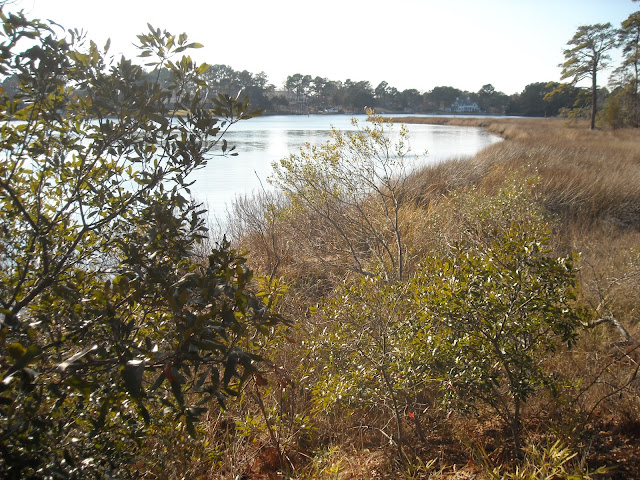Crossing the Great Divide (two of them, actually)
In just a few short weeks, I will be making my journey northwestward from the warm tidal area of the southern Chesapeake Bay towards the sandy and wind-driven dunes of the south shore of Lake Michigan. In doing so, I will be crossing many political boundaries. For a naturalist, though, I'll be crossing much more than just mere state lines and congressional districts, but I'll be traversing ecological boundaries.
I will likely cross two major geological boundaries on my road trip to the Hoosier State of Indiana. On the grandest scale, I will start off the in the Chesapeake Bay watershed and move across a great divide into the Mississippi/Ohio River watersheds. A watershed is simply an area of land that sheds surface water (such as rain or snow) into a larger body of water. For example, your gutters likely poor into a storm drain which empties out into a nearby stream, and then that stream drains to a river, which then flows to an ocean or a large bay. A great divide is that "invisible" boundary where, depending upon which side of the boundary you're on, that water from your gutter will end up in one place or another (in my case, I will cross a divide where water will end up flowing into the Mississippi River on one side and the Chesapeake Bay on the other). Everyone lives in a watershed.
Everyone lives in a watershed. Think about it. Everyone. The concept of a watershed is perhaps the most tangible fact that people can utilize in order to understand that people and ecosystems are all interconnected. In this case, one can no longer consider the concept of being 'interconnected' to be one of new-age, esoteric nonsense. That flow of water from your gutters, and whatever else may be in it, can and does affect people living downstream.
On my upcoming travels though, I'll be moving across not just ecosystems and watersheds, but rather I'll be crossing into different ecotones. Ecotones are a collection of ecosystems that are similar to each other in terms of their biodiversity (the different kinds of life they have there) and/or their climate. The following photo journal will show you what ecological transitions a naturalist such as myself sees on such a long car trip:
START
As I pull out of the drive way, I'll be leaving a region dominated by lush subtropical foliage in a wind-swept, salty maritime environment.
(the Chesapeake Bay watershed), I'll ride along the fall line of the Mid Atlantic Coastal Plain and the Piedmont. The Piedmont exhibits qualities similar to that of the coastal forests, only the terrain is more rocky and steep. This allows for large cliffs and overhangs dominated by Virginia Pine (Pinus virginiana) over tumbling waterfalls. The climate here is somewhat cooler, so northern-growing plants start to blend in with southern-growing plants.
I will likely cross two major geological boundaries on my road trip to the Hoosier State of Indiana. On the grandest scale, I will start off the in the Chesapeake Bay watershed and move across a great divide into the Mississippi/Ohio River watersheds. A watershed is simply an area of land that sheds surface water (such as rain or snow) into a larger body of water. For example, your gutters likely poor into a storm drain which empties out into a nearby stream, and then that stream drains to a river, which then flows to an ocean or a large bay. A great divide is that "invisible" boundary where, depending upon which side of the boundary you're on, that water from your gutter will end up in one place or another (in my case, I will cross a divide where water will end up flowing into the Mississippi River on one side and the Chesapeake Bay on the other). Everyone lives in a watershed.
Everyone lives in a watershed. Think about it. Everyone. The concept of a watershed is perhaps the most tangible fact that people can utilize in order to understand that people and ecosystems are all interconnected. In this case, one can no longer consider the concept of being 'interconnected' to be one of new-age, esoteric nonsense. That flow of water from your gutters, and whatever else may be in it, can and does affect people living downstream.
On my upcoming travels though, I'll be moving across not just ecosystems and watersheds, but rather I'll be crossing into different ecotones. Ecotones are a collection of ecosystems that are similar to each other in terms of their biodiversity (the different kinds of life they have there) and/or their climate. The following photo journal will show you what ecological transitions a naturalist such as myself sees on such a long car trip:
START
As I pull out of the drive way, I'll be leaving a region dominated by lush subtropical foliage in a wind-swept, salty maritime environment.
(the Chesapeake Bay watershed), I'll ride along the fall line of the Mid Atlantic Coastal Plain and the Piedmont. The Piedmont exhibits qualities similar to that of the coastal forests, only the terrain is more rocky and steep. This allows for large cliffs and overhangs dominated by Virginia Pine (Pinus virginiana) over tumbling waterfalls. The climate here is somewhat cooler, so northern-growing plants start to blend in with southern-growing plants.
 |
| Prickly pear cactus on a sand dune near the southern shoreline of Lake Michigan |









Comments
Post a Comment